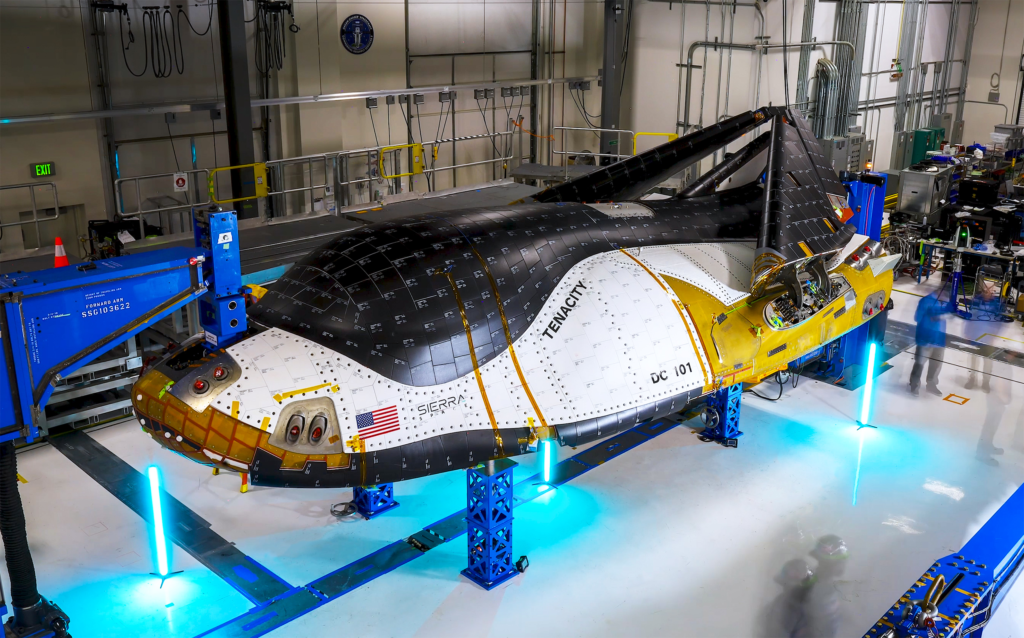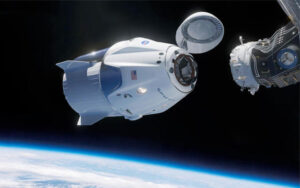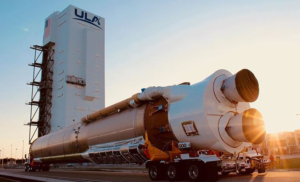
A Closer Look At The Inside of Dream Chaser Tenacity!
Over a decade ago, the Space Shuttle was one of the most prominent spacecraft with a total of over 100 missions. While by no means perfect, it’s responsible for a lot of the space infrastructure in use today from the Hubble Telescope to the International Space Station. Today, however, we are only a few months away from a new modern spaceplane expected to alter space access.
Dream Chaser Tenacity has been undergoing development and testing for years now and its set to lift off in only months. Taking a closer look at the vehicle’s design and interior highlights a long list of differences from the past Space Shuttle. From altered heat shield tiles, general size, vehicle compatibility, and mission profile, we haven’t quite seen a vehicle like it yet. Here I will go more in-depth into the vehicle’s internal design, its unique features, upcoming launch, and more.
Inside Dream Chaser Tenacity

Tenacity is only 30 feet (9 meters) long, roughly a quarter of the total length of the space shuttle. The interior is accessed via a hatch on the back of the spacecraft. Once opened, it reveals that a majority of the vehicle is empty, designed to maximize the amount of cargo that can be carried. This specific Dream Chaser spaceplane is part of the DC-100 line. This is Sierra Space’s classification for an uncrewed variant, in other words just meant for cargo. That being said, it will still eventually berth to the ISS, and Astroantus on board will open and access the inside of the vehicle.
In a new video released by the company, it showcases a few shots inside Tenacity as crews work on the vehicle. While still missing some side panels, it gives a good idea and perspective of the vehicle’s size and goal. The interior is primarily a large cylinder that is not big enough for most humans to stand in. That being said, it’s quite long and stretches the majority of the vehicle’s length. As you go closer toward the front, you eventually hit a wall right before the nose of the spaceplane.
On all sides of Teancity, different internal tanks, tech, etc all limit the available space inside to house necessary equipment. At the bottom for example, the vehicle has a few large storage spaces for the two wheels and extra landing gear. In tests and animations of the landing process, you can see that they fold in and out and that rather than a third wheel at the front, Sierra Space decided to use a skid plate. As far as why, in a recent tweet the company said, “In place of a nose wheel, Tenacity uses a skid plate. This helps maximize cargo space and reduce the complexity of the system, while maintaining safety.” Being a lot smaller and thinner, it doesn’t require a larger interior storage space similar to the wheels.
In total, Tenacity’s pressurized volume is 33 cubic meters (including both the spaceplane and the cargo module). Even though the interior space is not massive, it adds up and can carry a significant amount of cargo. Together they can carry around 13,000 pounds or 5900 kg. The Shooting Star module which attaches at the back accounts for around 70 percent of that weight. For comparison, SpaceX’s Dragon carries cargo in a pressurized capsule and an unpressurized trunk. It can carry 6,000 kilograms (13,228 pounds), split between pressurized cargo inside the capsule and unpressurized cargo in the trunk.
For Dream Chaser, because the Shooting Star Cargo module is not reusable, it can only return to Earth what will fit within the actual spaceplane. In total, the spacecraft will be capable of returning 1,750 kg (3,860 lb) to Earth while undergoing maximum re-entry forces of 1.5G. This is one of the biggest selling points of the vehicle as it ensures more fragile cargo can be brought back to land.
By now, astronauts have already been trained on the vehicle’s interior and operations. They won’t fly on the vehicle but they do need to have a decent understanding of how to access and safely operate parts of it. Specifically, last year in July, Sierra Space trained the SpaceX Crew-8 team. As of right now, it looks like they are scheduled to lift off on a crew Dragon in a few weeks in early March. They then will arrive at the ISS and stay there for 180 days. Within that time period, Sierra Space is expected to launch Tenacity and dock it to the station. This will be the crew to unload and load cargo on and off Tenacity for the first time.
A New Spaceplane

Tenacity is still at NASA’s Glenn Research Center undergoing final pre-launch testing. Assuming this all provides promising results, a launch this summer is expected. Until then, the teams still have a decent bit of work left. Looking at some of the videos provided by the company highlight that a decent portion of heat shielding still needs to be installed. The bottom for example is nearly empty which will take time to properly attach. There are also a few aero surfaces and unique spots that are missing tiles.
Earlier this month ULA CEO Tory Bruno tweeted saying, “Nothing quite as pretty on a Wednesday morning as a brand new shiny #BE4 rolling over to get installed on the next #Vulcan. Vulcan just launched successfully for the first time and the next vehicle is preparing to launch Dream Chaser. Based on Tenacity’s timeline, Vulcan is expected to be ready before or around the same time as the spaceplane.
Dream Chaser was selected by NASA to provide cargo delivery, return and disposal service for the International Space Station under the Commercial Resupply Service 2 (CRS-2) contract. Tenacity alone will provide a minimum of seven cargo missions to and from the space station carrying critical supplies like food, water, and science experiments. Each of those missions will be on the Vulcan Centaur.
It’s important to point out that Sierra Space is starting with an uncrewed Dream Chaser but has big plans for the future. Last year Sierra Space was awarded a Space Act Agreement (SAA) by NASA under the second Collaborations for Commercial Space Capabilities (CCSC-2) initiative. At the time in a statement, the company wrote, “Through the agreement, Sierra Space will provide NASA with valuable insight and collaboration into its crewed Dream Chaser® spaceplane; new commercial space station architectures; and in-space logistics, refueling and servicing systems. NASA will advance deployment of Sierra Space’s platform and ecosystem by providing access to facilities and support for environmental and crew systems testing, tools and software” they said.
Renders of the vehicle showcase a slightly different design featuring more engines, altered wings, and shape. The first flight of Tenacity and its subsequent missions will play a very important role in the development and design of the crewed version.
On Tenacity’s upcoming flight, Sierra Space has a lot to prove to NASA and themselves. After it’s launched and separated from Vulcan’s upper stage, the real mission begins. They mentioned that far-field demonstrations will be conducted outside the vicinity of the space station before the spacecraft enters the approach ellipsoid, an invisible boundary around the orbiting laboratory. These demonstrations will be required before Dream Chaser can enter joint operations with the NASA team at the Mission Control Center in Houston. These include demonstrating attitude control, translational maneuvers, and abort capabilities.”
After that, “Near-field demonstrations, which must happen closer to the space station, include activating and using light detection and ranging sensors, responding to commands sent from the space station, retreating from the station when commanded, and holding its approach. Following the successful completion of the demonstrations, Dream Chaser will move towards the space station.”
Here, as Dream Chaser approaches the orbiting laboratory, it will hold a final time approximately 38 feet (11.5 meters) from the space station, when a station crew member will use Canadarm2 robotic arm to grapple a fixture on the spacecraft’s cargo module before teams on the ground install the cargo module to an Earth-facing port on the Unity or Harmony module. Specifically, it will grab onto Shooting Star, which is attached to the back of Tenacity. On this first flight to the International Space Station, Dream Chaser is scheduled to deliver over 7,800 pounds (3,500 kg) of cargo. On future missions, Dream Chaser is being designed to stay attached to the station for up to 75 days and deliver even more. This cargo can be loaded onto the spacecraft as late as 24 hours prior to launch.
The return will be the last and one of the hardest parts. Here they will test the new and improved heat shield. Tenacity will be exposed to extremely high temperatures and pressure as it attempts to reenter the atmosphere. If it makes it through, it then needs to fly to the runway, deploy its landing gear, and make a soft landing. As partially mentioned prior, the plan is to use the Tenacity vehicle again and again for following missions to the ISS. This means it’s very important that the vehicle survives in at least decent shape. No matter what it will need to be refurbished but a complete loss during reentry for example would create large delays and hurt the program. Something Sierra Space wants to try and avoid at all costs.
Another uncrewed vehicle is under construction but likely still has a few years of work left. Ideally, they can have two operating spaceplanes in the future rather than having to rely on a single vehicle.
Conclusion
Dream Chaser Tenacity is a new kind of spaceplane that is almost ready for its maiden flight. Here it will attempt to dock to the ISS and stay there for months before a reentry and landing attempt. We will have to wait and see how it progresses and the impact it has on the space industry.




I’ve been surfing online more than three hours today, yet I never found any interesting article like yours.
It’s pretty worth enough for me. In my opinion, if all site
owners and bloggers made good content as you did, the internet will be much more useful than ever before.